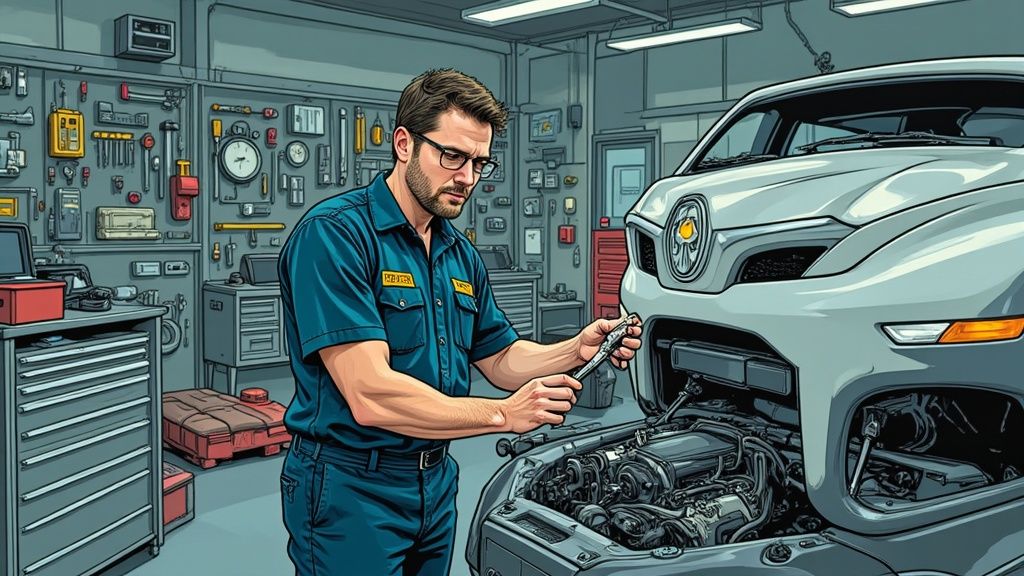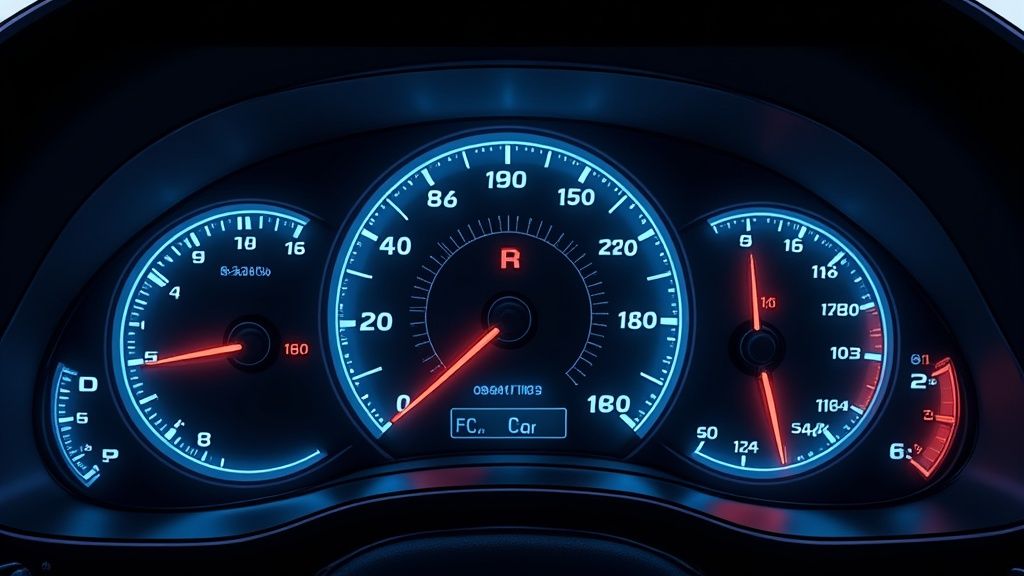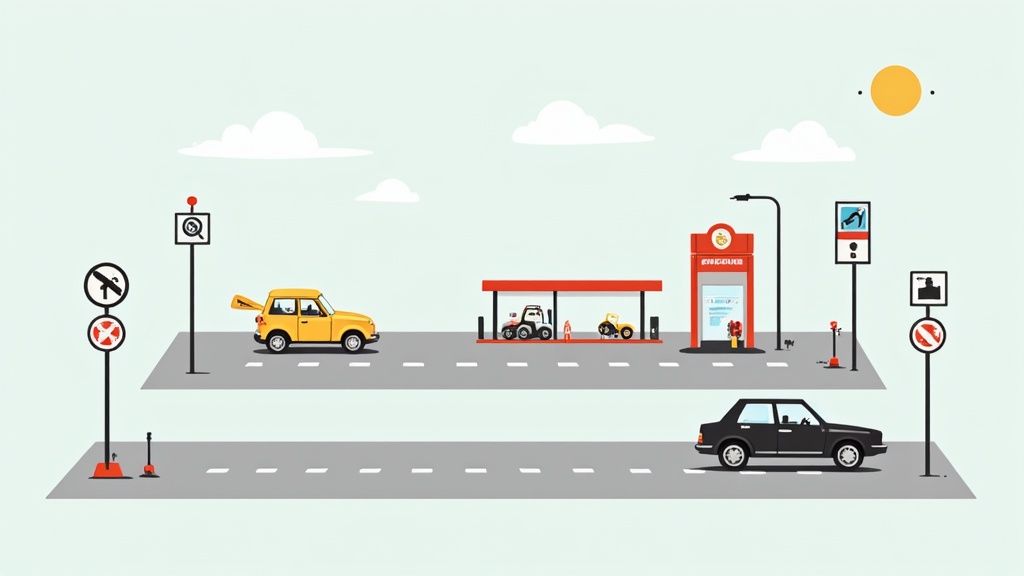
The Ultimate Vehicle Maintenance Schedule Template: Your Guide to Organized Car Care
Why Regular Vehicle Maintenance Is Non-Negotiable

Taking care of your vehicle is like maintaining your health - it requires consistent attention and preventive care. Just as you visit the doctor for check-ups, your car needs regular maintenance to run safely and efficiently. Without proper upkeep, you risk expensive repairs, poor fuel economy, and unsafe driving conditions. Understanding and following a maintenance schedule is essential for every vehicle owner.
The Impact of Neglecting Maintenance
When maintenance gets pushed aside, the consequences can be severe. For instance, skipping oil changes can destroy your engine, leading to repairs that cost thousands of dollars. Poor brake maintenance reduces your ability to stop safely, putting lives at risk. These issues highlight why regular servicing cannot be overlooked.
Recent data paints a concerning picture of vehicle maintenance in America. According to CARFAX’s October 2023 report, 29% of car owners have fallen behind on oil changes, while 44% haven’t rotated their tires as needed. For more insights, see the full report here: Carfax Data on Vehicle Maintenance. These numbers show an urgent need for better maintenance habits.
Boosting Longevity and Resale Value
Regular maintenance does more than prevent problems - it extends your vehicle’s life. Small issues can quickly become major headaches when ignored, but proper care keeps your car running smoothly for years. This attention to maintenance also pays off financially. A detailed service history proves you’ve taken good care of the vehicle, helping you get top dollar when it’s time to sell or trade in.
Prioritizing Maintenance Tasks and Early Warning Signs
While following a maintenance schedule is crucial, paying attention to warning signs helps catch problems early. Strange noises, vibrations, or fluid leaks often signal developing issues that need attention. Quick action on these signs prevents costly repairs later. To help track maintenance needs, Auto Service Logger offers tools for organizing service records and schedules. By combining routine maintenance with attention to warning signs, you’ll keep your vehicle reliable and avoid surprises.
Understanding Manufacturer-Recommended Service Intervals

Getting the most from your vehicle requires following the right maintenance schedule. While checking your owner’s manual can seem daunting at first, understanding the manufacturer’s service recommendations is essential for keeping your car running smoothly for years to come. Let’s break down the key aspects of vehicle service intervals and how to apply them effectively.
Decoding the Science Behind Service Intervals
Each part of your vehicle wears differently based on its function and exposure to stress. For example, engine oil faces constant high temperatures and friction, requiring frequent changes to maintain proper protection. Other components like brake fluid can last longer but still need periodic replacement for safety. This is why a vehicle maintenance schedule template must account for these varying service needs.
Your typical driving conditions also play a major role in maintenance timing. City driving with frequent stops puts more strain on brakes and transmission compared to highway cruising at steady speeds. If you mostly drive in stop-and-go traffic, you may need more frequent service than the standard intervals suggest. Weather extremes can also speed up wear on various components.
Adapting Recommendations to Individual Driving Patterns
While manufacturer guidelines provide a good starting point, experienced mechanics often adjust service timing based on how you actually use your vehicle. For instance, regularly towing heavy loads typically means more frequent transmission service is needed. Vehicles used off-road benefit from more frequent air filter changes. These adjustments help ensure your specific driving needs are met.
Original Equipment Manufacturer (OEM) recommendations form the foundation of most maintenance schedules. These guidelines aim to keep vehicles performing optimally through properly timed service. For example, MOTOR’s Maintenance Schedules provide detailed OEM maintenance timing with work estimates that help shops plan and execute service properly.
Interpreting Complex Service Schedules
Today’s vehicles require more than just oil changes and tire rotations. Modern maintenance schedules include specific timing for transmission service, cooling system maintenance, and electronic component checks. Understanding when and why these services are needed helps you maintain your vehicle properly. Auto Service Logger provides a simple way to track these maintenance items and keep all your service records in one place. Using a vehicle maintenance schedule template in the system helps you stay organized and on top of upcoming service needs.
Breaking Through Common Maintenance Barriers

Following a regular maintenance schedule is essential for keeping your vehicle running smoothly. Yet many car owners find it challenging to stay on top of routine service amid busy work and family commitments. Let’s explore the most common maintenance obstacles and practical ways to overcome them.
Time Constraints and Budget Limitations
Finding time for car maintenance can feel impossible when juggling a packed schedule. The costs can also seem daunting at first glance. But putting off needed service often backfires - small issues left unchecked tend to develop into major, expensive problems. A simple oil leak, for instance, could lead to serious engine damage if ignored.
Recent research from IMR highlights how widespread these challenges are. Their study found that 7.9% of drivers delay routine maintenance, with 33% citing scheduling difficulties and 30.3% pointing to cost concerns. Despite these delays, 91% still plan to get the work done eventually. For more details, check out the full report on Consumer Delay Vehicle Maintenance Stats.
Overcoming Technical Knowledge Gaps
Many car owners feel uncertain when dealing with mechanics because they lack technical understanding. This knowledge gap can lead to either avoiding needed repairs or agreeing to unnecessary work. Fortunately, there are resources available to help drivers better understand their vehicles and make informed maintenance decisions.
Finding Reliable Service Providers
Identifying trustworthy mechanics requires careful research. While personal recommendations and online reviews provide helpful guidance, building a relationship with a quality service provider takes time. This is where tools like Auto Service Logger become valuable - by helping you maintain detailed service records that you can share with any mechanic. Having a documented maintenance history helps you communicate more effectively about your car’s needs.
Building a Sustainable Maintenance Routine
The key to consistent car care is shifting from reactive repairs to planned maintenance. Using resources like Auto Service Logger’s vehicle maintenance schedule template helps establish this proactive approach. Learn more about Auto Service Logger. By scheduling regular service and tracking your vehicle’s history, maintenance becomes a normal part of car ownership rather than a dreaded chore. This organized approach typically saves money over time by preventing major issues and extending your car’s life.
Crafting Your Perfect Maintenance Schedule Template

A vehicle maintenance schedule template helps you stay ahead of car repairs and upkeep. Instead of just fixing problems as they occur, a good template lets you plan ahead and keep track of regular maintenance needs. Let’s explore how to create a template that works best for your vehicle.
Choosing the Right Template Format
Your maintenance schedule template should match your needs and preferences. A basic spreadsheet with columns for tasks, due dates/mileage, and completion records works well for tracking routine maintenance. For more complex needs, digital tools like Auto Service Logger offer features like automatic reminders and detailed reports - perfect if you manage multiple vehicles or need extensive tracking.
Essential Maintenance Markers
Every good maintenance schedule needs these key elements:
- Mileage Intervals: When to do oil changes, rotate tires, and handle other distance-based tasks
- Time Intervals: Schedule services like brake fluid changes that depend on time rather than miles
- Specific Tasks: List all needed maintenance items and inspections
- Service History: Keep records of completed work for future reference
Adjusting Your Schedule
Your maintenance needs change based on how you use your car. City driving or hauling heavy loads typically requires more frequent service than highway cruising. Older vehicles also need extra attention compared to newer models. Make sure your maintenance schedule reflects your actual driving conditions and vehicle age.
Organizing and Setting Reminders
Good organization makes maintenance tracking easier. Keep paper records in a dedicated folder or use digital tools to store service documents. Don’t forget to set up reminders - whether through your phone’s calendar or maintenance app alerts. Taking these simple steps helps prevent small issues from becoming major repairs.
Growing with Your Vehicle’s Needs
As your car ages and your driving habits evolve, so should your maintenance schedule. Review and update your template regularly, adding new tasks or adjusting service intervals based on your mechanic’s advice. This flexible approach ensures your car gets the right care at the right time, helping it run reliably for years to come.
Making the Most of Digital Tools for Vehicle Care
Managing vehicle maintenance effectively requires a structured approach. While a vehicle maintenance schedule template provides a good foundation, digital tools can take your maintenance tracking to the next level by making it easier to stay organized, communicate with service providers, and extend your vehicle’s life.
Selecting the Best Digital Solution
The market offers a range of tools to help track vehicle maintenance, from basic to advanced. Simple spreadsheet programs like Google Sheets or Excel work well for creating basic vehicle maintenance schedule templates with key information like service dates and mileage. For more capability, specialized apps like Auto Service Logger provide features such as automatic maintenance reminders, secure cloud storage, and detailed service reporting. These advanced tools are particularly helpful when managing multiple vehicles or tracking complex service histories.
Benefits of Mobile and Cloud Solutions
Modern maintenance apps put vehicle care information at your fingertips. Most apps allow you to access your vehicle maintenance schedule template across all your devices - phone, tablet, and computer. Cloud storage adds an extra layer of security and convenience by keeping your maintenance records safe and accessible anywhere. This proves especially valuable during mechanic visits when you need quick access to service history details.
Key Features and Cost Considerations
When picking a digital maintenance tool, look for essential features like service reminders, mileage tracking, and document storage capabilities. Consider the costs involved - while basic versions of many apps are free, premium features often require a subscription. Auto Service Logger offers a lifetime membership option with a one-time payment that includes full feature access and future updates.
Creating Long-Term Service Records
Maintaining detailed digital service records does more than keep you organized - it adds real value to your vehicle. Complete maintenance documentation shows prospective buyers that the vehicle has been well-cared-for, potentially increasing its resale value. Research from Manifestly shows that following structured maintenance checklists improves equipment longevity and efficiency. By using digital tools to track maintenance, you’re creating both better vehicle care habits and a valuable record of your vehicle’s history.
Making Your Maintenance Schedule Work Long-Term
Creating lasting vehicle maintenance habits is about more than just following a checklist - it’s about developing an approach that keeps your car healthy and valuable over many years. The key is to build reliable routines, work effectively with service providers, and adjust your maintenance as your vehicle ages.
Maintaining Consistency and Coordination
Just as regular exercise benefits your health, consistent maintenance prevents small issues from becoming major repairs. Making this work requires active planning - not just having a schedule on paper. One effective approach is using digital tools like Auto Service Logger to set reminders and track service appointments. Building a strong relationship with your mechanic is equally important. Take time to discuss how you use your vehicle and any specific concerns so they can provide the most appropriate service recommendations.
Documenting Service History and Tracking Expenses
Keeping detailed maintenance records serves multiple purposes. Your service history acts as a health record for your vehicle, showing all repairs, regular maintenance, and any recurring problems. This documentation proves especially valuable when selling your car, as buyers appreciate seeing evidence of consistent care. Additionally, tracking costs for each service visit helps you understand your true ownership expenses and plan future budgets more effectively.
Adapting Your Schedule Over Time
A car’s maintenance needs change as it accumulates miles and years. The service schedule that worked when your vehicle was new may need adjustments as it ages. Be prepared to increase certain service frequencies and add inspections for components like belts, hoses, and suspension parts that naturally wear over time. Research common issues for your specific make and model to anticipate potential problems. By staying flexible and proactive with your maintenance approach, you can provide appropriate care throughout your vehicle’s life.
Ready to take better control of your vehicle’s long-term care? Start tracking your service history with Auto Service Logger today to keep your car running smoothly for years to come.